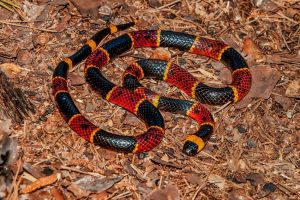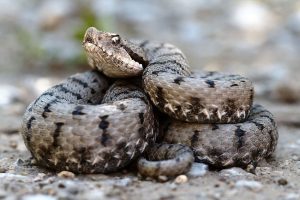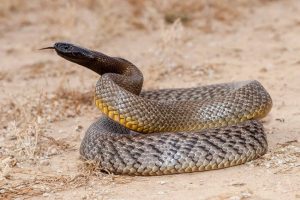The distinctive rattling sound of the Eastern Diamondback Rattlesnake has become a familiar sound in many Hollywood movies. This venomous snake is the second-largest in North America, with a large and long body. These snakes are reclusive and avoid people whenever possible. Typically, bites from this rattlesnake happen when humans trespass on their territory. Let’s explore this species with Know All Animals in the following article!
Scientific classification
- Kingdom: Animalia
- Phylum: Chordata
- Class: Reptilia
- Order: Squamata
- Suborder: Serpentes
- Family: Viperidae
- Genus: Crotalus
- Species: C. adamanteus
1. 4 Astonishing Facts About Eastern Diamondback Rattlesnakes
- They are the second-longest venomous snake in North America, with the number one spot belonging to the Eastern Rattlesnake.
- They shed their skin once a year.
- They can regrow their fangs several times a year.
- Males grow much larger than females and compete for the right to mate with them.
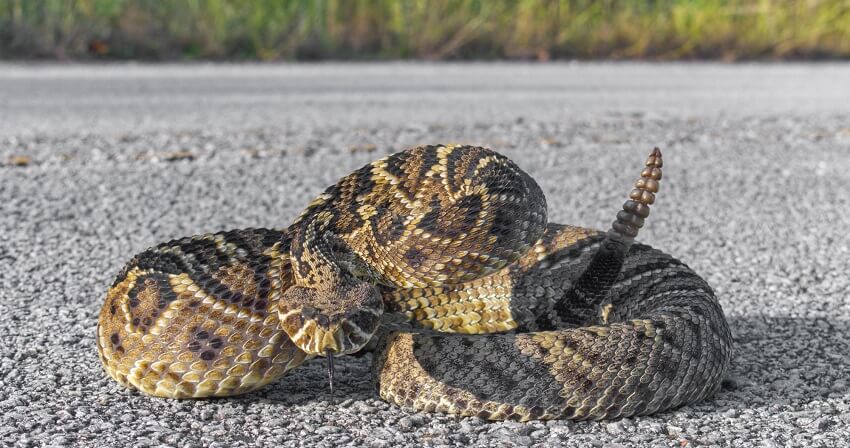
2. Where Do Eastern Diamondback Rattlesnakes Live?
The Eastern Diamondback Rattlesnake lives in the Southeastern United States and northern Mexico. They prefer to live in arid and semi-arid desert conditions and are often found hiding under vegetation or other cover, such as rocks, branches, and debris.
Some Eastern Diamondback Rattlesnakes migrate in the spring and fall. In the spring, males often compete for dominance and the right to reproduce. However, the snakes typically do not injure each other during this process.
Like many other venomous snakes, Eastern Diamondback Rattlesnakes are born, not hatched. About 165 days after mating, the female gives birth to 10–20 young rattlesnakes. Within a few hours, they go off on their own to find shelter and food. The majority of young rattlesnakes do not survive their first year, as they become prey for many other animals.
3. Types of Diamondback Rattlesnakes
Diamondback Rattlesnakes are named for their diamond-shaped markings and the rattling sound of their tails. They live primarily in the southwestern United States and northern Mexico. Here are the most common species of Diamondback Rattlesnake:
Western Diamondback Rattlesnake (Crotalus atrox): Found in the southwestern United States and northern Mexico.
Eastern Diamondback Rattlesnake (Crotalus adamanteus): Lives in the southeastern United States, primarily Florida and Alabama.
Red Diamondback Rattlesnake (Crotalus ruber): There are three recognized subspecies, including the Cedros Island red diamond rattlesnake (C. r. exsul), the San Lucan red diamond rattlesnake (C. r. lucasensis), and the red diamond rattlesnake (C. r. ruber). They live in the southwestern corner of California, south to the tip of Baja California, on a few islands in the Gulf, and near the Pacific coast.
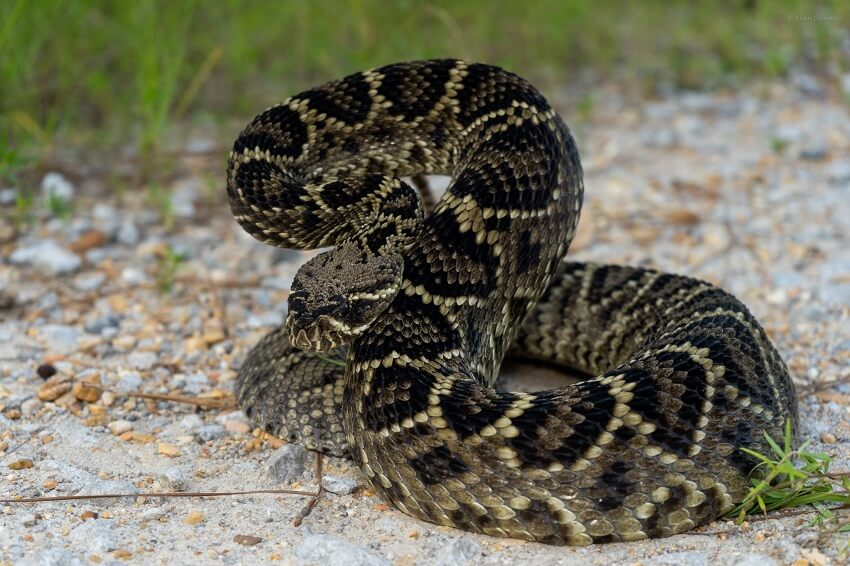
4. Population and Conservation Status of Eastern Diamondback Rattlesnakes
This snake species is not in danger of extinction. They thrive in the desert southwest and have a stable population. In 2007, the IUCN listed the Eastern Diamondback Rattlesnake as being of Least Concern in its Red List.
However, rattlesnake roundups still occur in some areas. This unfortunate practice pushes local ecosystems out of balance with a serious loss of many predators at once.
These snakes face a number of threats, including habitat destruction and predation. Diamondback rattlesnakes are often attacked and preyed upon by animals such as hawks, wild boars, owls, king snakes, and Texas indigo snakes.
5. Characteristics of the Eastern Diamondback Rattlesnake
Eastern Diamondback Rattlesnakes can be about 2.5 meters long (up to 8 feet) when they are born and can grow to be 4-7 feet long (1.2-2.1 meters) as adults. Typically, they weigh 3 to 6 pounds, but some individuals can weigh up to 15 pounds.
A rattlesnake’s skin is a tan or gray color, and some have a slightly pink, red, or orange hue. Their bodies have dark spots that run down the length of their back.
The Eastern Diamondback Rattlesnake has thick, keeled scales that make it look dull rather than shiny. Their heads are twice as wide as their necks. Their tails have a rattle with alternating black, white, and gray bands, which is the signature characteristic of this species.
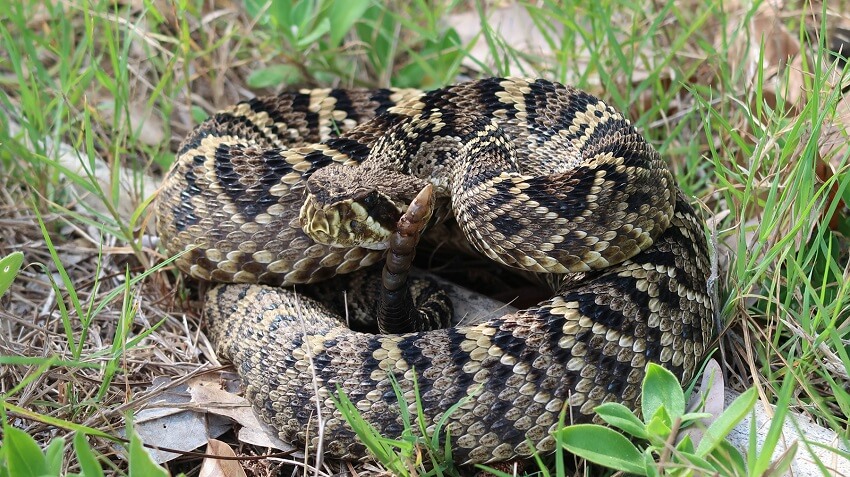
6. How Dangerous Are Eastern Diamondback Rattlesnakes?
Eastern Diamondback Rattlesnakes are reclusive and avoid people. They only attack humans when they feel threatened.
The venom of most Eastern Diamondback Rattlesnakes tends to be less potent than that of other rattlesnake species. However, the venom is still strong enough to cause nerve paralysis and severe injury to a victim.
According to DovMed, the venom of the Diamondback rattlesnake is “a hemotoxin and cytotoxin, which affects the blood and cardiovascular systems as well as the muscles of the body.” Rattlesnake venom contains components that help them digest their food, so they prefer to save their venom for hunting.
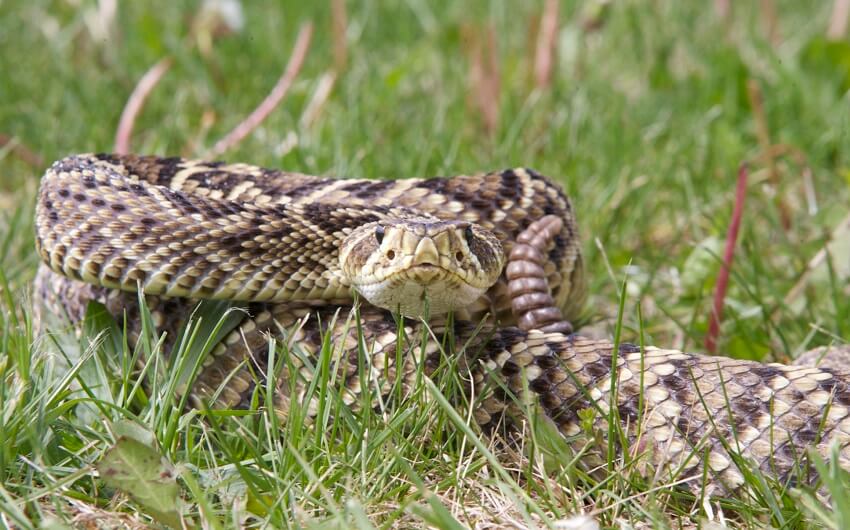
7. Eastern Diamondback Rattlesnake: Behavior and Humans
The diet of these snakes includes small mammals, mice, birds, rabbits, squirrels, and sometimes lizards. They are primarily nocturnal and use their nostrils and eyes to locate prey.
This snake species is most active during the day in the cool spring months. However, in the hot summer, they are only active at night. When hunting, the Diamondback rattlesnake hides in a concealed spot and waits for its prey to get close. A 1976 study that tracked the feeding habits of the Diamondback rattlesnake showed that the majority of their diet consisted of small mammals.
Eastern Diamondback Rattlesnakes often rattle their tails to show their displeasure with humans or other animals that have trespassed on their territory. At this point, they can attack and bite you at any moment to defend themselves.
References: https://en.wikipedia.org/wiki/Eastern_diamondback_rattlesnake

